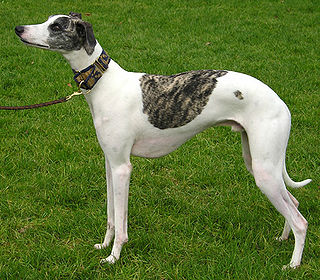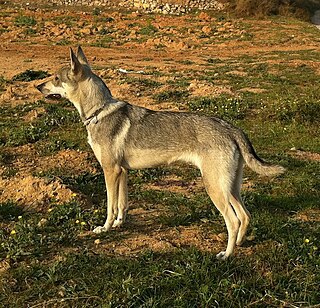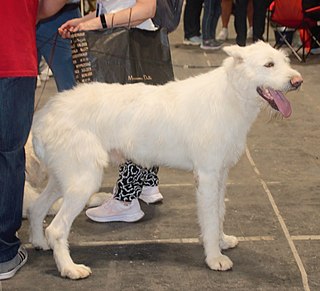
The beagle is a breed of small scent hound, similar in appearance to the much larger foxhound. The beagle was developed primarily for hunting hare known as beagling. Possessing a great sense of smell and superior tracking instincts, the beagle is the primary breed used as a detection dog for prohibited agricultural imports and foodstuffs in quarantine around the world. The beagle is intelligent and is a popular pet due to its size, good temper, and a lack of inherited health problems.

The Ibizan Hound is a lean, agile dog of the hound family. There are two hair types of the breed: smooth and wire. The more commonly seen type is the smooth. Some consider there to be a third type, long, but the longhair is most likely a variation of the wire.

Sighthounds, also called gazehounds, are a type of dog, hounds that hunt primarily by sight and speed, rather than by scent and endurance as scent hounds do.

The Pharaoh Hound or Kelb tal-Fenek is a Maltese breed of hunting dog. It is traditionally used for rabbit-hunting in the rocky terrain of the islands; the Maltese name means "rabbit dog".

A hound is a type of hunting dog used by hunters to track or chase prey.
Lure coursing is a sport for dogs that involves chasing a mechanically operated lure. Competition is typically limited to dogs of purebred sighthound breeds. The AKC has a pass/fail trial for all breeds called the Coursing Ability Test (CAT) and a timed 100 yard dash called Fast CAT where the dog's speed is converted to points.

The Grand Basset Griffon Vendéen or GBGV is a dog breed from France.

The Presa Canario is a Spanish breed of large dog of mastiff or catch dog type. It originates in the autonomous region of the Canary Islands, and is found mostly in the islands of Gran Canaria and Tenerife. It was formerly known as the Dogo Canario. It was traditionally used as a guard dog, as a herding dog for both sheep and cattle, and for dog-fighting, which was legal in Spain until 1936 and may have continued clandestinely thereafter.

The Petit Basset Griffon Vendéen, or PBGV, is a breed of dog of the scent hound type, bred to trail hares in bramble-filled terrain of the Vendée district of France. The breed is known in the United States as "Petit" or "PBGV," in England as "Roughie," and in Denmark as "Griffon" or "Petit". The PBGV is one of six types of "basset"-type breeds recognised by the Fédération Cynologique Internationale (FCI).

The Portuguese Podengo, also known as the Podengo Português or Portuguese Warren Hound, is a hound breed from Portugal. As a breed, the Podengo is divided into three size categories that are not interbred: small (Pequeno), medium (Médio) and large (Grande). Their coats are either short and 'smooth', or longer and 'wired'. The smooth coated variety is traditional, whereas the wire coated variety is an outcome of the assimilation of various other breeds during the 20th century. In general, the breed is healthy; the Pequeno (small) variety has an average lifespan of approximately 15–17 years.

The Ratonero Bodeguero Andaluz is a Spanish breed of dog of the terrier type. Its name reflects its main occupation: hunting rats and mice hidden between barrels in the wineries of Andalusia in Spain. It was recognised as an indigenous Spanish breed in 2000 by the Spanish Ministry of Agriculture and by the Spanish Kennel Club, the Real Sociedad Canina de España.

The Cirneco dell'Etna is an Italian breed of hunting dog from the Mediterranean island of Sicily. It is named for the Etna volcano in eastern Sicily. It has a keen sense of smell, and is used to hunt small game, particularly rabbits. As with many working dogs, registration is conditional on successful completion of a working trial.

The Sabueso Español or Spanish Hound is a scenthound breed with its origin in the far north of Iberian Peninsula. This breed has been used in this mountainous region since hundreds of years ago for all kind of game: wild boar, hare, brown bear, wolf, red deer, fox, roe deer and chamois. It is an exclusive working breed, employed in hunting with firearms.

The Podenco Andaluz is an ancient Spanish breed of warren hound used to hunt small game in Andalusia, Spain. It is one of four podenco breeds recognized by the Real Sociedad Canina de España. It is an agile dog generally used to hunt ducks, rabbits, boar and fowl. There are three accepted sizes and three coat types.

The Ratonero Valenciano, also known as the Gos Rater Valencià, is a breed of dog that originates in Spain. Recognised by the Real Sociedad Canina de España in 2004, it has had recent success with a member of the breed winning the Spanish National Dog Show in 2011. It is a traditionally docked breed. In 2022, the FCI finally recognised the breed, naming it rather "Terrier" than "Ratter".

The Podenco Valenciano or Xarnego Valenciano is a hound breed of dog originating in Valencian Community, Spain. This breed is known by several names, according to the different areas of the Valencian geography: Xarnego, Xarnego Valenciano, Gos coniller, Podenco Valencíano. It was officially recognized by the Real Sociedad Canina de España in 2017.

The Lobito Herreño or Perro de Pastor Herreño is a Spanish breed or type of pastoral dog. It is found mostly on the island of El Hierro in the Canary Islands, but also on Gran Canaria, La Palma and Tenerife. It is not recognised as breed by the Real Sociedad Canina de España, but in 2021 was one of three breeds or types listed as a grupo étnico canino, which the society defines as a regional dog population with consistent form and function evolved through functional selection. The other two dogs in this group are the Podenco Orito Español and the Carea Castellano-Manchego.
The warren hounds are a group of Mediterranean rabbit-hunting dog breeds. In Spanish, this type of breed is called podenco, in Catalan coniller, and in Portuguese podengo.

The Valdueza or Perro Montero Valdueza is a modern Spanish breed of large pack-hound. It results from selective breeding, principally of large rough-haired Podenco Andaluz dogs with lightweight examples of the Mastín Extremeño; some Griffon Vendéen blood was later added. Breeding began in the 1940s; in 2020 the Valdueza was officially recognised by the Ministerio de Agricultura, Pesca y Alimentación, the Spanish ministry of agriculture, and was added to the list of indigenous Spanish breeds. It is not recognised by the Fédération Cynologique Internationale.


















